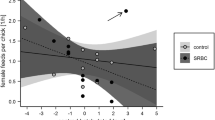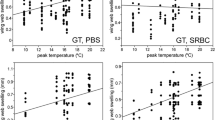Abstract
The immune system is an important defence against pathogens but requires resources that hosts may also use otherwise. Thus, trade-offs between investment in immunity versus other life-history traits may exist, especially during resource-demanding periods such as reproduction. Here, we investigated the potential trade-off between an activated immune system and parental care in free-living great tits. We also studied whether variation in baseline immune indices prior to immunization contributes to individual differences in the responses to an immune challenge. To this end, we injected free-living great tit females with either phosphate-buffered saline (PBS) or with bacterial lipopolysaccharides (LPS) when nestlings were 9 days old and subsequently recorded parental feeding rates. We quantified potential fitness consequences via the growth and survival of their nestlings. Exposure to LPS tended to decrease female feeding rates. However, nestling body mass was not affected by the maternal immune challenge, probably because males compensated for the change in feeding rate of their partner. We found a negative relationship between haptoglobin levels and female feeding rates pre-treatment, but not with any of the other innate immune traits. Although there was substantial variation in female innate immune indices, we found no evidence that baseline immunity affected how females reacted to an immune challenge in terms of changes in parental behaviour.




Similar content being viewed by others
References
Abbas AK, Lichtman AH (2010) Basic immunology: functions and disorders of the immune system. Saunders/Elsevier, Philadelphia
Bates D, Maechler M, Bolker B, Walker S (2013) lme4: linear mixed-effects models using Eigen and S4. R package version 1.0-4, http://CRAN.R-project.org/package=lme4.
Boes M (2000) Role of natural and immune IgM antibodies in immune responses. Mol Immunol 37:1141–1149
Bonneaud C, Mazuc J, Gonzalez G, Haussy C, Chastel O, Faivre B, Sorci G (2003) Assessing the cost of mounting an immune response. Am Nat 161:367–379
Buehler DM, Bhola N, Barjaktarov D, Goymann W, Schwabl I, Tieleman BI, Piersma T (2008) Constitutive immune function responds more slowly to handling stress than corticosterone in a shorebird. Physiol Biochem Zool 81:673–681
Christe P, Oppliger A, Richner H (1994) Ectoparasite affects choice and use of roost sites in great tit, Parus major. Anim Behav 47:895–898
Christe P, Richner H, Oppliger A (1996) Begging, food provisioning, and nestling competition in great tit broods infested with ectoparasites. Behav Ecol 7:127–131
Cichon M, Dubiec A (2005) Cell-mediated immunity predicts the probability of local recruitment in nestling blue tits. J Evol Biol 18:962–966
Clayton DH, Wolfe ND (1993) The adaptive significance of self-medication. Trends Ecol Evol 8:60–63
Costantini D, Møller AP (2009) Does immune response cause oxidative stress in birds? A meta-analysis. Comp Biochem Physiol A 153:339–344
Cray C, Zaias J, Altman NH (2009) Acute phase response in animals: a review. Comparative Med 59:517–526
Deerenberg C, Arpanius V, Daan S, Bos N (1997) Reproductive effort decreases antibody responsiveness. Proc R Soc Lond B 264:1021–1029
Demas GE, Nelson RJ (2012) Ecoimmunology. Oxford University Press, Oxford
Fang HQ, Pengal RA, Cao XH, Ganesan LP, Wewers MD, Marsh CB, Tridandapani S (2004) Lipopolysaccharide-induced macrophage inflammatory response is regulated by SHIP. J Immunol 173:360–366
Gray DA, Marais M, Maloney SK (2013) A review of the physiology of fever in birds. J Comp Physiol B 183:297–312
Harrison F, Barta Z, Cuthill I, Szekely T (2009) How is sexual conflict over parental care resolved? A meta-analysis. J Evol Biol 22:1800–1812
Hasselquist D, Nilsson JA (2012) Physiological mechanisms mediating costs of immune responses: what can we learn from studies of birds? Anim Behav 83:1303–1312
Ilmonen P, Taarna T, Hasselquist D (2000) Experimentally activated immune defence in female pied flycatchers results in reduced breeding success. Proc R Soc Lond B 267:665–670
Janssens E, Dauwe T, Bervoets L, Eens M (2001) Heavy metals and selenium in feathers of great tits (Parus major) along a pollution gradient. Environ Toxicol Chem 20:2815–2820
Knowles SCL, Nakagawa S, Sheldon BC (2009) Elevated reproductive effort increases blood parasitaemia and decreases immune function in birds: a meta-regression approach. Funct Ecol 23:405–415
Kurtz J, Kalbe M, Aeschlimann PB, Häberli MA, Wegner KM, Reusch TBH, Milinski M (2004) Major histocompatibility complex diversity influences parasite resistance and innate immunity in sticklebacks. Proc R Soc Lond B 271:197–204
Lochmiller RL, Deerenberg C (2000) Trade-offs in evolutionary immunology: just what is the cost of immunity? Oikos 88:87–98
Matson KD, Ricklefs RE, Klasing KC (2005) A hemolysis-hemagglutination assay for characterizing constitutive innate humoral immunity in wild and domestic birds. Dev Comp Immunol 29:275–286
Matson KD, Tieleman BI, Klasing KC (2006) Capture stress and the bactericidal competence of blood and plasma in five species of tropical birds. Physiol Biochem Zool 79:556–564
Matson KD, Horrocks NPC, Versteegh MA, Tieleman BI (2012) Baseline haptoglobin concentrations are repeatable and predictive of certain aspects of a subsequent experimentally-induced inflammatory response. Comp Biochem Physiol A 162:7–15
McKean KA, Yourth CP, Lazzaro BP, Clark AG (2008) The evolutionary costs of immunological maintenance and deployment. BMC Evol Biol 8:76
Merilä J, Andersson M (1999) Reproductive effort and success are related to haematozoan infections in blue tits. Ecoscience 6:421–428
Millet S, Bennett J, Lee KA, Hau M, Klasing KC (2007) Quantifying and comparing constitutive immunity across avian species. Dev Comp Immunol 31:188–201
Møller AP, Cassey P (2004) On the relationship between T-cell mediated immunity in bird species and the establishment success of introduced populations. J Anim Ecol 73:1035–1042
Møller AP, Saino N (2004) Immune response and survival. Oikos 104:299–304
Møller AP, Martίn-Vivaldi M, Soler JJ (2004) Parasitism, host immune defence and dispersal. J Evol Biol 17:603–612
Moreno J, Merino S, Sanz JJ, Arriero E, Morales J, Tomás G (2005) Nestling cell-mediated immune response, body mass and hatching date as predictors of local recruitment in the pied flycatcher Ficedula hypoleuca. J Avian Biol 36:251–260
Murata H, Shimada N, Yoshioka M (2004) Current research on acute phase proteins in veterinary diagnosis: an overview. Vet J 168:28–40
Murphy K, Travers P, Walport M, Janeway C (2012) Janeway’s immunobiology. Garland Science, New York
Nordling D, Andersson M, Zohari S, Gustafsson L (1998) Reproductive effort reduces specific immune response and parasite resistance. Proc R Soc Lond B 265:1291–1298
Norris K, Evans MR (2000) Ecological immunology: life history trade-offs and immune defense in birds. Behav Ecol 11:19–26
Ochsenbein AF, Zinkernagel RM (2000) Natural antibodies and complement link innate and acquired immunity. Immunol Today 21:624–630
Poxton IR (1995) Antibodies to lipopolysaccharide. J Immunol Methods 186:1–15
Quaye IK (2008) Haptoglobin, inflammation and disease. Trans Roy Soc Trop Med Hyg 102:735–742
Raberg L, Nilsson JA, Ilmonen P, Stjernman M, Hasselquist D (2000) The cost of an immune response: vaccination reduces parental effort. Ecol Lett 3:382–386
Saino N, Bolzern AM, Møller AP (1997) Immunocompetence, ornamentation, and viability of male barn swallows (Hirundo rustica). P Natl Acad Sci USA 94:549–552
Sanz JJ, Kranenbarg S, Tinbergen JM (2000) Differential response by males and females to manipulation of partner contribution in the great tit (Parus major). J Anim Ecol 69:74–84
Sheldon BC, Verhulst S (1996) Ecological immunology: costly parasite defences and trade-offs in evolutionary ecology. Trends Ecol Evol 11:317–321
Siikamäki P, Ratti O, Hovi M, Bennett GF (1997) Association between haematozoan infections and reproduction in the Pied Flycatcher. Funct Ecol 11:176–183
Verhulst S, Riedstra B, Wiersma P (2005) Brood size and immunity costs in zebra finches Taeniopygia guttata. J Avian Biol 36:22–30
Vermeulen A, Müller W, Matson KD, Tieleman BI, Bervoets L, Eens M (2015) Sources of variation in innate immunity in great tit nestlings living along a metal pollution gradient: an individual-based approach. Sci Total Environ 508:297–306
Williams TD, Christians JK, Aiken JJ, Evanson M (1999) Enhanced immune function does not depress reproductive output. Proc R Soc Lond B 266:753–757
Acknowledgments
We greatly thank Jel D’Hollander for assisting in the field, Josie Meaney-Ward for improving the English and Thomas Raap for his valuable comments on the manuscript. Further, we would like to thank Kevin D. Matson for teaching us the immune techniques. We would also like to thank the University of Antwerp for funding.
Author information
Authors and Affiliations
Corresponding author
Ethics declarations
Conflict of interest
The authors declare that they have no conflict of interest.
Ethical approval
This study was approved by the ethical committee of the University of Antwerp (ID number 201131), and it was performed in accordance with Belgian and Flemish laws.
Funding
This study was made possible by a PhD studentship to AV from the University of Antwerp.
Informed consent
This article does not contain experiments with human participants.
Additional information
Communicated by I. R. Hartley
Significance Statement
Innate immunity is a central component of vertebrate immunity, representing the first line of defence. However, there is a large amount of among individual variation in baseline innate immunity, potentially indicating differences in individual defence strategies, as baseline levels may be costly to maintain while being central for the effectiveness of a first immune response. To study the adaptive significance of baseline innate immunity levels, we investigated whether the trade-off between raising an immune response and parental provisioning depended on (previously measured) baseline innate immunity levels. We found only weak support for the existence of a trade-off, which was also unaffected by the levels of baseline innate immunity. Thus, the functional consequences of variation in innate immunity levels remain unclear, urging for further studies to explore the relatively unknown field of innate immunity.
Rights and permissions
About this article
Cite this article
Vermeulen, A., Eens, M., Zaid, E. et al. Baseline innate immunity does not affect the response to an immune challenge in female great tits (Parus major). Behav Ecol Sociobiol 70, 585–592 (2016). https://doi.org/10.1007/s00265-016-2077-3
Received:
Revised:
Accepted:
Published:
Issue Date:
DOI: https://doi.org/10.1007/s00265-016-2077-3




